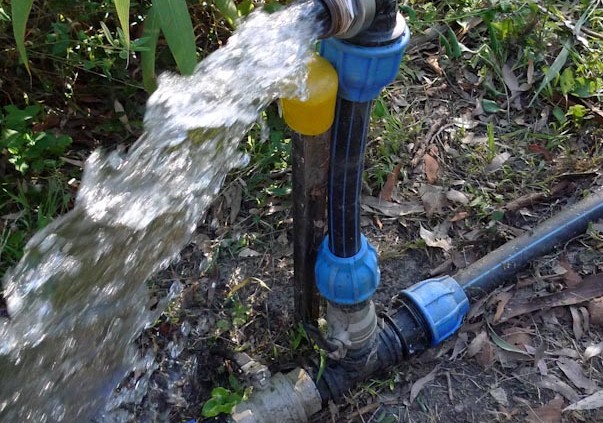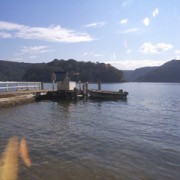History
Thirty plus years ago, there was a water tank at Bell (for fire-fighting purposes) where the current meters are located. This tank was filled via a pipe under the water from the mainland and a tap, with mainland water pressure, was fitted. A local resident with a water tanker would fill from the tank and deliver water to residents. Around 1978, some residents purchased polypipe and intermittently connected to the high pressure tap. It worked so successfully that many more residents followed and the emergency water polypipe line came into existence.
This worked for residents within an easy radius to the main connection but others, particularly on the eastern side linked to the pipe over the top of the Island, became increasingly frustrated with the rate of flow or lack off! These residents proposed an extension of the existing pipelines around the ring road.
In 1986, Warringah Council threatened to cut off the water supply and said they would no longer carry any responsibility for the service. On hearing SIRA representations Council decided on the following strategy.
In 1988, Warringah Council set the charges for water on the basis the supply was for emergencies only. In 1992, Pittwater Council formalised the arrangement, appointing Water Monitors for each line as agents for Council, with requirements for record keeping of water purchased, meter readings and depositing monies at Council.
In 1993, Sydney Water confirmed its position to supply the Island with wastewater services, if water services were deemed appropriate, with the implication that the cost of this servicing would be borne by the residents.
In 1994, Pittwater Council installed line meters, however, the existing pipeline remained and ultimately became inefficient due to breakages, illegal connections and access difficulties. There was also an increasing concern of pollution of the pipeline from ground water as some sections had been buried underground.
In 1997, Sydney Water confirmed that a preliminary water servicing strategy has been developed and would cost $3m to construct (approx $10,000 per household). This would have to be paid for by residents. A wastewater strategy would be additional.
In May 2002, Pittwater Council declared that the emergency water line distribution system would be disconnected and the water tank with a tap for emergency use would be reinstated. This decision followed Council’s liability concerns where water was being delivered to residents by a sub-standard system.
SIRA proceeded to enter into urgent negotiations to upgrade the emergency water line. Following legal advice, a Water Agreement was drawn up to be signed by each household, outlining the terms of delivery of water when required. In addition, each household acknowledges that the water provided is not for potable use. Each purchaser must be a fully paid up member of SIRA thereby providing public liability cover for the supply of water to residents via the emergency lines.
The cost of water has remained (without any increase) as set by Warringah Council in 1988 and is administered by Water Monitors, who are reimbursed for their time and expenses. SIRA reimburses Pittwater Council quarterly for the Sydney Water account and surplus funds have been used to upgrade all the lines to the standards and specifications advised by Sydney Water. This upgrade was rolled out as funds permitted and is now complete. However, scheduled maintenance and repairs to the pipeline is still required.
SIRA commissioned a Water and Waste Water Study in 1997, which recommended options for water and sewerage to Scotland Island. Sydney Water was requested, both from Pittwater Council and SIRA, to provide these services.
Sydney Water has indicated that planning for wastewater services would commence 2011 and water services would only be considered if Island residents were prepared to contribute the majority of the funds required.
SIRA established both the Emergency Water Service Group and the Water and Wastewater Working Group many years ago and has made numerous attempts to resolve the issue of improved water services. This team is progressing various issues with the support and involvement of Pittwater Council, our local State member, as well several Island residents and is continuing to press Sydney Water for commitment and funding to a sustainable water servicing strategy to the Island.
Following discussions with Pittwater Council and Sydney Water in 2004, SIRA agreed to take on the responsibility of managing, upgrading and maintaining the Emergency Water Line, subject to residents entering into an Agreement for Sale of Water (contract) to purchase water. SIRA sought legal advice and was advised to take out public liability insurance and, in addition, each resident would be required to be a member of SIRA to further mitigate against liability. Sydney Water classifies the water as non-potable.
In 2018, SIRA received a NSW government grant to implement an electronic booking system and to establish automated meter readings, invoicing and valve operation at the Bell manifold. The booking system came into operation in March 2019, initially only operated by the water monitors. From April 2019, residents were making their bookings online. In May 2020, the automation for meter reading and valve operation became operational after an online education campaign for residents via video conferencing (this was during the COVID-19 pandamic).
During the 2019/2020 drought it became clear that combined with a lowered mains water pressure, the system was not able to deliver the demand for emergency water. The residences at the top of the island experienced water flows of less than 300 litres per hour. It was decided by SIRA to invest in a pressure-assist system to boost water delivery rates and enable everyone on the island to receive reasonable volumes of water. For this the platform at Bell neeeded to be strengthened and a new installation with pumps was installed. This latest addition to the water system of Scoltland Island became operational in April 2021.







Leave a Reply
Want to join the discussion?Feel free to contribute!